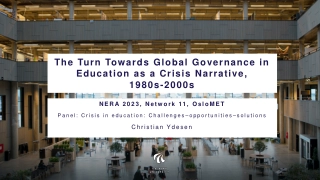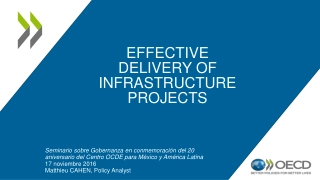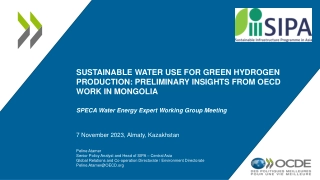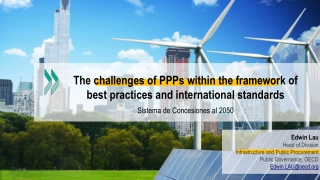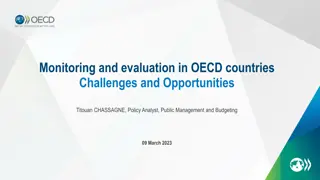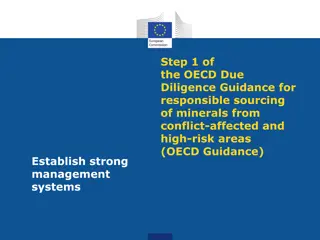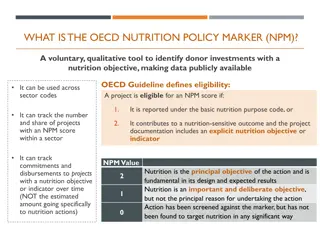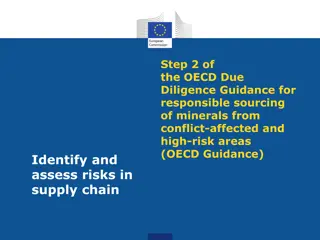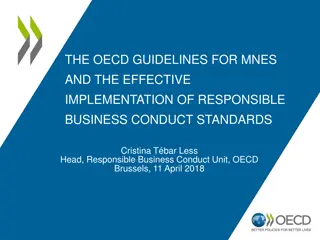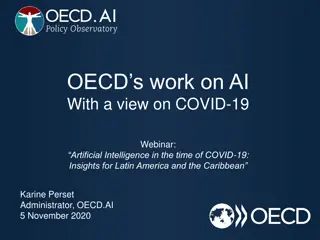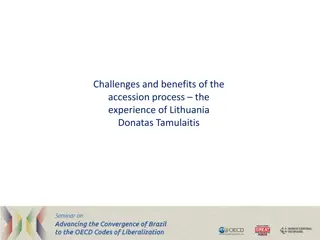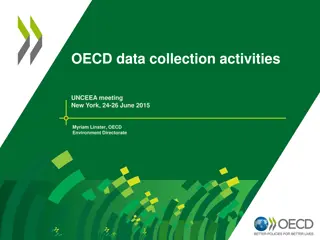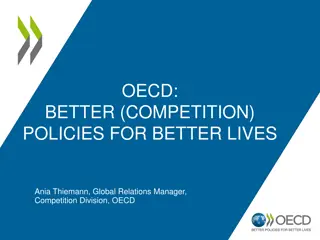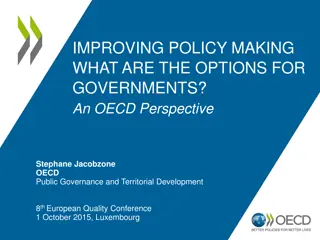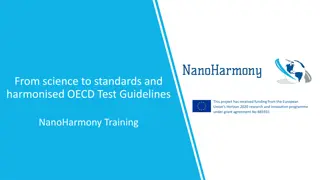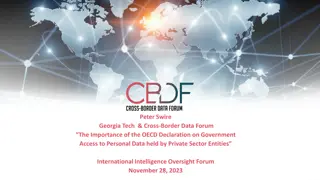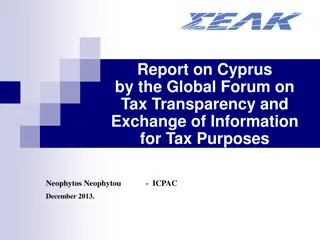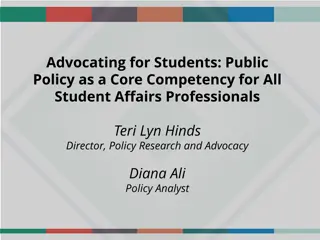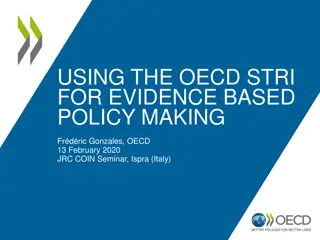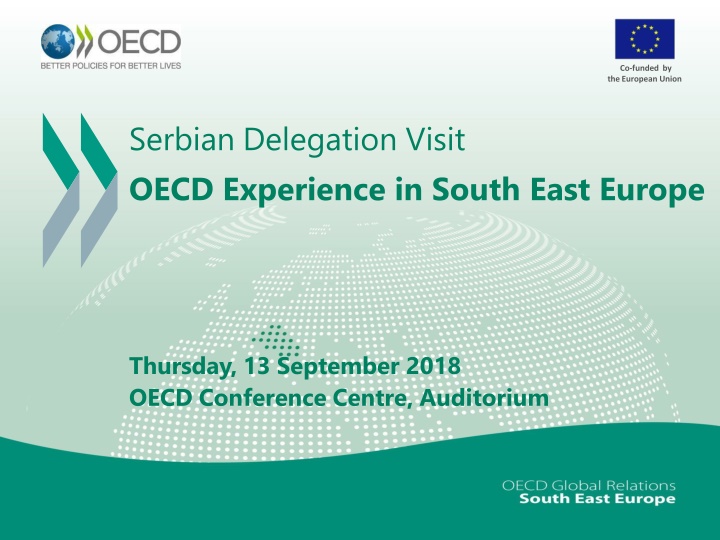
OECD: A Closer Look at Policy Areas and Global Reach
Detailed overview of the Organisation for Economic Co-operation and Development (OECD), covering its missions, governance structure, South East Europe regional programme, and key policy areas. Explore OECD's fast facts, membership details, global reach, and the roles of different entities within the organization. Gain insights into the challenges and potential solutions related to public-private dialogue and consultation processes in Serbia.
Download Presentation

Please find below an Image/Link to download the presentation.
The content on the website is provided AS IS for your information and personal use only. It may not be sold, licensed, or shared on other websites without obtaining consent from the author. If you encounter any issues during the download, it is possible that the publisher has removed the file from their server.
You are allowed to download the files provided on this website for personal or commercial use, subject to the condition that they are used lawfully. All files are the property of their respective owners.
The content on the website is provided AS IS for your information and personal use only. It may not be sold, licensed, or shared on other websites without obtaining consent from the author.
E N D
Presentation Transcript
Co-funded by theEuropean Union Serbian Delegation Visit OECD Experience in South East Europe Thursday, 13 September 2018 OECD Conference Centre, Auditorium
Agenda for today Agenda for today 1. Present the general missions of the OECD, its governance and the role of public-private dialogue and public consultation processes within the Organisation 2. Present the mission and activities of the OECD South East Europe regional programme, highlighting consultations carried out as part of our work 3. Point to a few useful OECD references on PPD and PPC 4. Listen to your vision of the main challenges you are facing regarding PPD and PPC in Serbia and discuss potential solutions 2
Fast facts Established: Headquarters: OECD Centres: 1961 Paris Berlin, Mexico City, Tokyo, Washington 36 Angel Gurr a (Mexico) ~2 500 374 M (2017) Members: Secretary-General: Secretariat staff: Annual budget: Nearly 300 expert committees and working groups with participation of +100 countries 4
OECDs global reach Ongoing membership talks with Russia (suspended) 36 member countries Newest members: Lithuania Latvia Estonia Israel Slovenia Chile KeyPartners: Brazil China India Indonesia South Africa 5
Policy areas covered Agriculture and fisheries Bribery and corruption Chemical safety and Biosafety Competition Corporate governance Development Economy Education Employment Environment Finance Green growth and sustainable development Health Industry and entrepreneurship Innovation Insurance and pensions International migration Internet Investment Public governance Regional, rural and urban development Regulatory reform Science and technology Social and welfare issues Tax Trade 6
Who does what? Council Oversight and strategic direction, presided by the Secretary-General Committees National experts discussion, monitoring and peer review Secretariat Research, analysis and policy recommendations 7
Characteristics of OECD work Takes a multidisciplinary approach Collaborates with many different ministries Offers evidence-based, independent policy advice Provides decisions via consensus Monitors members progress through peer reviews Seeks and sets best practice standards Does not provide financial assistance 8
Peer review An initially unique method Examination of each country s policies and practices by experts from other countries - the examination is done by peers, i.e. policy makers who face similar problems in their countries. It is a discussion among equals. Effective tool for policy improvement thanks to: Peer pressure The same methodology and criteria to assess performance for all countries Systematic and recurring monitoring mechanism Peer learning and capacity building 10
Business and trade unions representations at the OECD Business and Industry Advisory Committee (BIAC) Trade Union Advisory Committee (TUAC) International business network with global and cross-sectoral membership Represents major business associations in OECD member countries and key partners Communicates business perspectives in annual consultations with OECD ambassadors and OECD ministerials Provides strategic counsel on OECD policy instruments Brings together over 58 national trade unions representing some 66 million workers in OECD countries Access to OECD discussions enables proactive engagement in policy debate Conveys trade union positions in annual meetings and OECD ministerials Submits policy inputs to the OECD 11
The OECD South East Europe Regional Programme
The OECD and Serbia Serbia is not a member of the OECD, but is an Invitee in 11 OECD bodies/projects and has adhered to 6 OECD instruments Participates in SIGMA Active member in the activities of the Anti-corruption Network for Eastern Europe and Central Asia Member of the four programmes of the OECD Agricultural Codes and Schemes Full member of the International Transport Forum Serbia s contact point at the OECD is the Global Relations Secretariat Serbia participates in the SEE regional programme since its inception 13
Introduction to the OECD SEE regional programme Provides policy advice to improve economic reform agendas and foster competitiveness & SME development in: o Albania, Bosnia and Herzegovina, Bulgaria, Croatia, the Former Yugoslav Republic of Macedonia, Kosovo*, Moldova, Montenegro, Romania, Serbia and Turkey; Close partnership with European Commission, which is main donor and relies on Programme s work for its technical assistance programming. Strong legacy: Established in 2000, it is the oldest regional programme at the OECD; Local presence through high-level national project co-ordinators and comprehensive in-country stakeholder networks; 2015 MCM Mandate for further strengthening OECD relations with SEE going forward; New website: www.oecd.org/south-east-europe *Thisdesignationis withoutprejudice to positionson status,and is in line withUNSCR1244 and the ICJ Opiniononthe Kosovodeclarationof independence. 14
Overview of ongoing projects and activities 3 key work streams Competitiveness Outlook Small Business Act assessment EconomicReformProgrammes 15
An example of our work The Competitiveness Outlook in video 16
Methodology: Competitiveness Outlook & SME Policy Index ASSESSMENT FRAMEWORK DEVELOPMENT by OECD with regional organisations and OECD experts Phase 1 INDEPENDENT ASSESSMENT by OECD and local experts involving the private sector OFFICIAL STATISTICS from SEE economies, and regional and international organisations SELF-ASSESSMENT by SEE government officials Phase 2 RECONCILIATION: ECONOMY AND REGIONAL LEVELS OECD, SEE government officials, regional organisations and private sector to reach consensus Phase 3 ANALYSIS AND DRAFTING Phase 4 OECD, SEE government officials, regional organisations and experts to review and finalise PUBLICATION LAUNCH At Summit/High-level-event and across the SEE region Phase 5 17
Inclusiveness of projects: Competitiveness Outlook & SME Policy Index OECD GRS Policy Analysts OECD Regional Expert Organisations Directorates SEE International Experts Governments CO & SBA Co-ordinators Local Experts Private Sector Representatives Statistical Offices 18
Competitiveness Outlook: Main objectives and impact The most wide-ranging assessment of economic policy performance of the Western Balkans today: 17 policy dimensions key to economic competitiveness; 6 economies: Albania, Bosnia and Herzegovina, the Former Yugoslav Republic of Macedonia,Kosovo*, Montenegro,and Serbia; Change management tool for policy makers at various levels of government and across most government ministries and agencies for competitiveness-enhancing policy making; Road map for regional economic policy reform; Reference for the European Commission to build the EU enlargement process; Catalyst for inter-ministerial co-operation and intra-regional integration; Guide for investors to make informed investment decisions; Toolkit for donors and international development agencies to prioritise funding choices; A complete body of knowledge contributing to the research community and debate. 19
A broad scope: 17 policy dimensions Sustainability / Economic Structure 1.Agriculture 2.Environment 3.Energy 4.Culture and Tourism 5.Transport Skills and Capacity Business Environment Governance 6.Education and Competences 7.Employment 8.Digital Society 9.Research, Development and Innovation 10.Investment Policy and Promotion 11. Trade Policy and Facilitation 12.Access to Finance 13. Tax Policy 14. Competition Policy 15.State-owned Enterprises 16. Anti- corruption 17.Effective Public Services 20
SBA Assessment: Main Objectives and Impact Overall Objective of the Small Business Act Assessment: Supporting the PrivateSectorDevelopmentin the Western Balkans and Turkey The only comprehensive assessment of SME policies for the six Western Balkan economies and Turkey, its results are periodically reflected in the flagship publication SME POLICY INDEX the next one to be published in May 2019. A reference document for policymakers to benchmark against EU & OECD good practices and standards; Improved SME policy-making and enhanced the capacityof policy-makers; Encouraged co-ordination among ministries on cross-cutting SME Policies; Resulted in more systematiccollection of certain information and statistical data; Inclusive policymakingby engaging private sector and civil society actors; 21
A broad Policy Scope: SME Policy Index based on Small Business Act for Europe principles 2 Access to finance Institutional, regulatory and operational environment 1 Dimension 6: Access to finance for SMEs Dimension 3: Regulatory framework for SME policy making Dimension 4: Operational environment for SMEs Dimension 2: Bankruptcy and second chance for SMEs 3 Human capital Dimension 1: Entrepreneurial learning and women s entrepreneurship Dimension 8a: Enterprise skills 4 Support measures for SME competitiveness Dimension 8b: Innovation policy for SMEs Dimension 5a: Support services for SMEs and start-ups 5 SME internationalisation Dimension 10: Internationalisation of SMEs Dimension 7: Standards and technical regulations Dimension 5b: Public procurement Dimension 9: SMEs in a green economy OECD South East Europe 22
SBA Assessment Support to Implementation Assist policy makers in the SME Index recommendations implementationwith regional policy dialogue meetings and capacity building activities Peer learning at the core to foster regionalco-operation in the Western Balkans; Providing practicalexamplesto policy makers by sharing OECD-EU good practices Enhancing the understandingand awareness of cutting edge SME policies Regional Policy Dialogue Capacity Building activities 1stmeeting: Alternative FinancialInstruments 2ndmeeting: Encouraging Linkages between SMEs and Multinational Firms 3rdmeeting: Bankruptcyand SecondChance Policies 4th meeting: SMEGreening Policies A study visit to Istanbul on SME and Academia Collaboration to share Turkey s Experience in Innovation and Technology Centres 23
Economic Reform Programmes (ERPs) Objectives Enable structural change for increased competitiveness of Western Balkan economies Improve economic governance as a key requirement for EU membership Transition towards a functioning market economy as set out in the Copenhagen criteria Foster inter-ministerial co-ordination to ensure coherency between macroeconomic projections, state budget expenditure and reform plans Strengthen institutional capacities to identify structural constraints, to develop and prioritise policy responses to anticipate the potential impact of structural reforms on economic growth and job creation to implement effectively reforms and monitor reform progress Reinforce the policy-dialogue with civil society stakeholders 24
OECDs role in the ERP cycle and recent outputs Capacity Building Analytical Support Hands-on assistance to the ERP Co- ordinators and line ministries in building and enhancing institutional capacity to prepare the ERP Substantive inputs through specific policy analyses and practical tools: guidance in the application, review the outputs, additional suggestions Over 10 policy roundtables and capacity- building seminars conducted in Paris and SEE capitals More than 500 government officials from SEE attended policy roundtables and seminars ERP Tools provide practical guidance in the diagnosing constraints, prioritising and monitoring reforms Report on SEZ with new insights on benefits and risks in the WB 25
Process of the annual ERP cycle August- September: Review of relevant sources and documents to provide ERP support. June - July: Kick-offevents and seminars in the capitals. May: ERP launch event in Brussels & bilateralmeetings. November - December: Stakeholders consultations in the countries. September- November:Policy seminars and capacity building events. October- November: OECD reviews 1stERP drafts. February- April: ERPassessment and new guidelines. 31 January:Countries submit final ERP 2017-19to the EC. December:OECD reviews 2nd ERP drafts. 26
Some OECD resources on public-private consultations (PPCs)
Assessment of PPCs in the Western Balkans Competitiveness Outlook 2018: chapter 16. Public Services in South East Europe SBA Assessment: SME Policy Index Dimensions a 1. Entrepreneurial learning and women s entrepreneurship (ETF) Bankruptcy and second chance for SMEs (OECD) Institutional and Regulatory framework for SME policy making (OECD) Operational Environment (OECD) SME support services (OECD) and public procurement (OECD/SIGMA) Access to finance for SMEs (EBRD) Technical standards (OECD) Enterprise skills (ETF) and innovation policy for SMEs (OECD) SMEs in a green economy (OECD) 10. Internationalisation of SMEs (OECD) through numerous interviews with businesses, chambers of commerce and entrepreneurs 2. 3. 4. 5. Public-private consultations Part of the assessment: sub-dimension 3.3 Evaluation of the frequency, transparency, formal influence and inclusiveness of public-private consultations 6. 7. 8. Dialogue with the private sector representatives important feature of the project Examination of the effectiveness of the SME policies 9. 28
Assessment of PPCs in the Western Balkans (contd) Main challenges in the Western Balkans Consistent implementation of PPCs is still lacking despite the formal requirement to conduct them: majority of gov. acts still adopted through an urgent procedure Centralised on-line platforms for PPCs were introduced in majority of the WBT economies, yet they are underutilised Councils to facilitate consultations with interested parties are increasingly being formed, but their effectiveness is dubious Systematic efforts to improve the quality and effectiveness of PPCs are generally lacking: no bodies that oversee the implementation of consultations and check for their quality OECD South East Europe Regional Programme 29
OECD Good practices on PPCs (1/3) Denmark s Business Forum for Better Regulation Aim: identify areas where companies experience the greatest burdens and propose simplifications (changing rules, introducing new processes or shortening processing times) Members of the Business Forum: industry and labour organisations, businesses, as well as experts with expertise in simplification. How it works: meets 3 times a year to decide which proposals to send to the government. The Forum defines themes where simplification of regulation was most promising. Within these themes, specific changes are proposed by the Forum (in total 13 themes). Proposals from the Business Forum are subject to a "comply or explain" principle. This means that the government is committed to either implement the proposed initiatives or to justify why initiatives are not implemented. Key strengths: The comply or explain principle and the openness of the forum together with the direct input from businesses and business organisations ensuring that the proposals represent the needs of the business sector. Results: by October 2016: 603 proposals were sent to Government, of which so far 191 were fully and 189 partially implemented; annual burden reduction of the initiatives estimated at ~EUR 100 M 30
Good practices on PPCs (2/3) ICT tools in fostering PPCs - the Slovak Republic s government consultation portal Aim: provide a single access point for public authorities as well as the general public to comment on legislative proposals and non-legislative drafts. How it works: members of the general public must register at the government portal and can then submit written comments on any legislative proposal. Written comments can either be submitted as INDIVIDUAL or as COLLECTIVE COMMENTS , to which individuals or organisations can signal their support. Whenever a comment receives support from 500 individuals or organisations, ministries are obliged to provide written feedback on the comment either taking the comment into consideration for the legislative proposal or explaining why the comment has not been taken into account. The feedback provided is then part of the dossier submitted to the government for discussion. Key strengths: possibility to use its structure at all stages of the legislative process Results: practically all legislative proposals are adjusted following the consultation process 31
Good practices on PPCs (3/3) Finland s website for early-stage consultations Have your say (otakantaa.fi) Aim: as part of the E-participation environment project which lasted from 2010-2014, the eParticipation platform otakantaa.fi was relaunched in order to enable better interaction with the broader public during the early phase of policy-making. How it works: the website allows both public officials and members of the general public to start discussions on various topics (from drafting new laws to mapping needs and ideas for new policies). On the platform, projects and initiatives are categorised by geography (i.e., if a topic is specifically relevant for certain cities or regions within Finland) and by keywords which can be chosen by the initiators of projects. To participate, two different tools exist: discussion forums and web surveys. The inputs vary between long and detailed comments with some idea or evidence and short opinions or votes signalling participants agreement or disagreement. The initiator provides a summary of the discussions or the results of the survey, which is attached to other drafting material used in the decision-making process. Key strengths: platform is flexible and simple, possibility to use its structure at all stages of the legislative process; feedback collected in a short time thanks to the tools Results: by January 2016, 354 projects or initiatives have been started. 32
Relevant OECD work on PPCs Recommendation of the Council on Regulatory Policy and Governance (2012) OECD Regulatory Policy Outlook (2015) Regulatory Policy by Country (2015) Measuring Regulatory Performance (2015) Indicators of Regulatory Policy and Governance: Design, Methodology and Key Results (2015) Pilot database on stakeholder engagement practices in regulatory policy (2016) Annual Country Assessment Reports (WBT region) Competitiveness Outlook (2018) SME Policy Index 2019 (to be published in spring 2019) 33
Co-funded by theEuropean Union Thank you for your attention! For further information, please consult our new website: www.oecd.org/south-east-europe and contact: Ms. Marzena KISIELEWSKA Head of the OECD South East Europe Division e-mail: marzena.kisielewska@oecd.org 34

